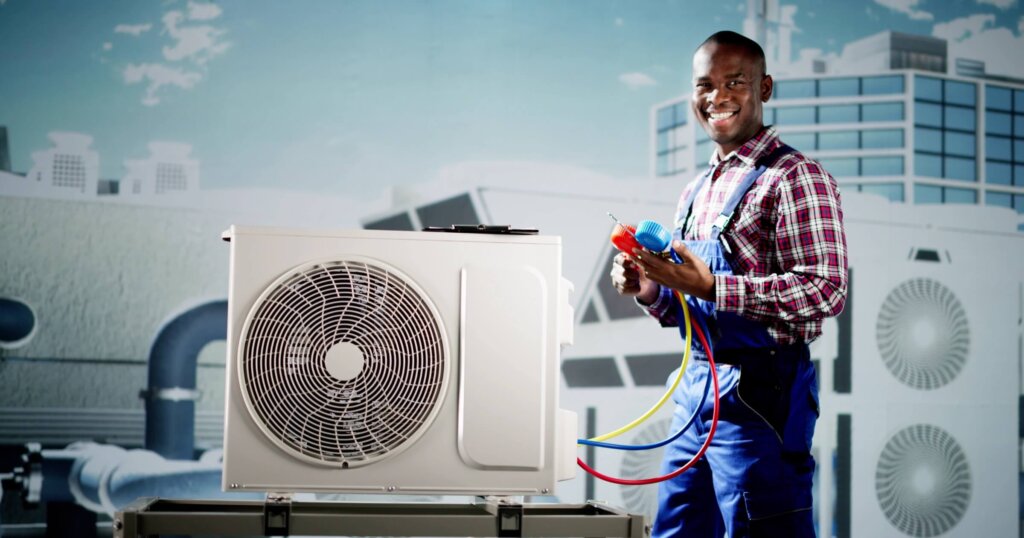Thinking about a career as an HVAC technician in the United States? You’re not alone. With consistent demand and solid pay, the HVAC field is one of the most practical trades to get into. This guide walks you through how to become an HVAC technician, how long it takes, what it costs, and the steps needed to start working in the field.
How long does it take to become an HVAC technician?
Most people can become an HVAC technician in six months, but it can take up to two years, depending on the route they take. Certificate programs from technical schools typically take six to twelve months, while associate degrees usually take about two years. Some folks jump right into an HVAC apprenticeship, which can last between three to five years but includes paid on-the-job training, providing you with practical experience while you learn.
Timing depends on a few things:
- Whether you go full-time or part-time
- If you attend an HVAC training program or go straight into the field
- Whether your state requires a license and how long it takes to qualify
If you want to work faster, look for fast-track programs or union apprenticeships that combine practical work with classes. Apprenticeships are an excellent opportunity to gain experience with hands-on training and get you into the field sooner.
Is it hard to become an HVAC technician?
HVAC is a hands-on trade that requires learning refrigeration systems, working in tight spaces, and sometimes dealing with extreme temperatures. It’s not as physically demanding as roofing or framing but more technical than general labor. You must understand refrigerant cycles, electrical circuits, and airflow.

Learning the skills to work in the HVAC industry can be challenging, especially for people not used to working with their hands or reading schematics. But if you’re mechanically minded or enjoy troubleshooting, it gets easier over time. Compared to trades like welding or plumbing, HVAC sits in the middle in terms of difficulty.
How much does it cost to become an HVAC technician?
Expect to spend $1,200 to $15,000, depending on the training path.
Here’s the breakdown:
- Technical school certificate: $1,200–$7,500
- Associate degree: $8,000–$15,000 for two years
- Online programs: $1,500–$5,000
- Tools and materials: $500–$2,000
- Environmental Protection Agency (EPA) certification (required): ~$100–$200
Some unions and employers cover the cost of your HVAC certification if you go through an apprenticeship. You’ll earn a paycheck while learning, which can offset costs significantly.
6 steps to become a certified HVAC technician in the U.S.
Step 1: Get your high school diploma or GED
You need a high school diploma or GED to qualify for most HVAC programs or apprenticeships. Formal education with courses like math and physics or shop classes can give you a head start, especially if they cover basic electrical concepts or mechanical systems.
Step 2: Choose your training path
Decide whether you want to attend a trade school, community college, or an apprenticeship. Trade schools offer shorter programs, while community colleges offer associate’s degrees or technician certifications that might open doors for future advancement. Apprenticeships take longer but pay while you learn.
Step 3: Get EPA Section 608 certified
This is part of the licensing requirements if you are handling refrigerants, which is a big part of the HVAC job. The EPA Section 608 certification exam has four types; most technicians go for Type II or Universal. Many schools include this in the HVAC program, but you can also study and take it independently.
Step 4: Gain work experience or complete an apprenticeship
Hands-on experience is the most essential part of HVAC training. You’ll learn mechanical skills, problem-solving skills, installing equipment, and safely handling tools and chemicals. If you’re not in an official apprenticeship, look for internships or entry-level jobs that give you field exposure.
Step 5: Get licensed (if your state requires it)
Some states require an HVAC license, which usually means passing an exam and working a certain number of hours. Licensing rules vary by state, so check with your local licensing board before applying for jobs.
Step 6: Look for entry-level HVAC jobs
Once you’ve got your certification and hands-on experience, start applying. There are many career opportunities for a licensed HVAC technician. Typical starting roles include HVAC helper, maintenance tech, or installation assistant. From there, you can specialize, earn more, and eventually go out independently.
Salary expectations for HVAC technicians

According to the U.S. Bureau of Labor Statistics, the average salary for HVAC technicians in the U.S. is $51,390 per year, or about $24.70 per hour. Entry-level positions often start around $35,000 annually, but with a few years of experience, that can rise significantly, especially in high-demand regions or specialties.
Top earners in the field can make $75,000 or more. Those who work overtime hold different certifications (like the North American Technician Excellence NATE certification or EPA 608 Universal). You can also specialize in commercial systems, which can earn even more.
An HVAC technician’s salary varies by location, with the highest average wages in Alaska, the District of Columbia, and Hawaii. HVAC professionals working in metropolitan areas like San Francisco, Boston, or New York also earn more due to higher living costs and demand.
Job outlook
Job opportunities for HVAC technicians are expected to grow 6% from 2022 to 2032, which is faster than the average for all occupations. New construction, an aging workforce, and the need to replace or upgrade older systems to meet energy efficiency standards fuel this growth.
States with booming populations and warm climates, like Texas, Florida, Arizona, and California, offer tons of job prospects. Additionally, there’s increasing demand for techs who understand smart HVAC systems and sustainable building practices.
Advancement opportunities
HVAC is a skilled trade with a clear pathway for advancement. With experience and the proper certifications, many techs move into lead installer or service manager roles, often overseeing a team or managing projects.
Others become estimators, building automation specialists, or HVAC engineers. Technicians with an entrepreneurial mindset may eventually open their own businesses, offering both residential and commercial services.
Specializing in refrigeration, solar HVAC systems, or industrial controls can also lead to higher-paying positions. Continuing education, apprenticeships, and manufacturer training programs all help accelerate career growth.
Tips for success as an HVAC technician in the U.S.
- Practice your math skills — You must be comfortable with basic algebra and formulas for calculating airflow, pressure, or voltage. Good math skills can save you time on the job and help you avoid costly mistakes.
- Learn basic customer service — Many HVAC techs deal directly with homeowners, property managers, or business clients. Being polite, clear, and professional can lead to better reviews, more referrals, and repeat work.
- Keep your tools in great shape — Well-maintained tools last longer and help you work faster and more safely. Make it a habit to regularly clean, store, and inspect your gear.
- Show up on time and ready to work — Reliability is one of the top traits employers and clients look for in a technician. A good attitude and strong work ethic will help you stand out, even when starting.
- Stay organized — You’ll often juggle multiple service calls, parts orders, and paperwork in a single day. Keeping things tidy and following a routine can reduce stress and boost efficiency.
- Study for and pass your EPA exam early — It’s required if you plan to work with refrigerants, and many employers won’t hire without it. Getting it done early puts you ahead of other entry-level candidates.
- Keep learning — HVAC systems are evolving fast, with smart thermostats, energy-efficient units, and new refrigerants hitting the market. Staying current with industry trends will keep you competitive and open the door to higher-paying roles.
Is an HVAC technician a promising career?
HVAC is a solid career choice for people who like working with their hands, solving problems, and being in the field. It’s especially strong in areas with population growth, commercial development, or extreme weather. Federal and state incentives for clean energy upgrades have also created more demand for HVAC work, and this will likely increase the average wage faster than other skilled trades.
HVAC also offers steady employment. With the current shortage of skilled trades in the U.S., technicians are in short supply, making job security high. Many union locals offer strong support systems, training, and benefits, making it an attractive career.
Final thoughts
Becoming an HVAC technician takes focus and some upfront work but is relatively fast compared to most careers, even in skilled trades. You can train in under a year, earn while you learn, and move up quickly if you put in the effort. If you’re serious about getting started in the trades, HVAC is a bright path.
If you’re exploring career options in skilled trades, check out our list of resources here to help you decide the best path:
- The best trade apprenticeships in construction
- Entry-level construction jobs
- How apprenticeships give students a one-up in the trades
- Your guide to apprenticeships
Want tips like this straight to your inbox? Join our newsletter and stay updated with practical advice, job ideas, and stories from the field.


